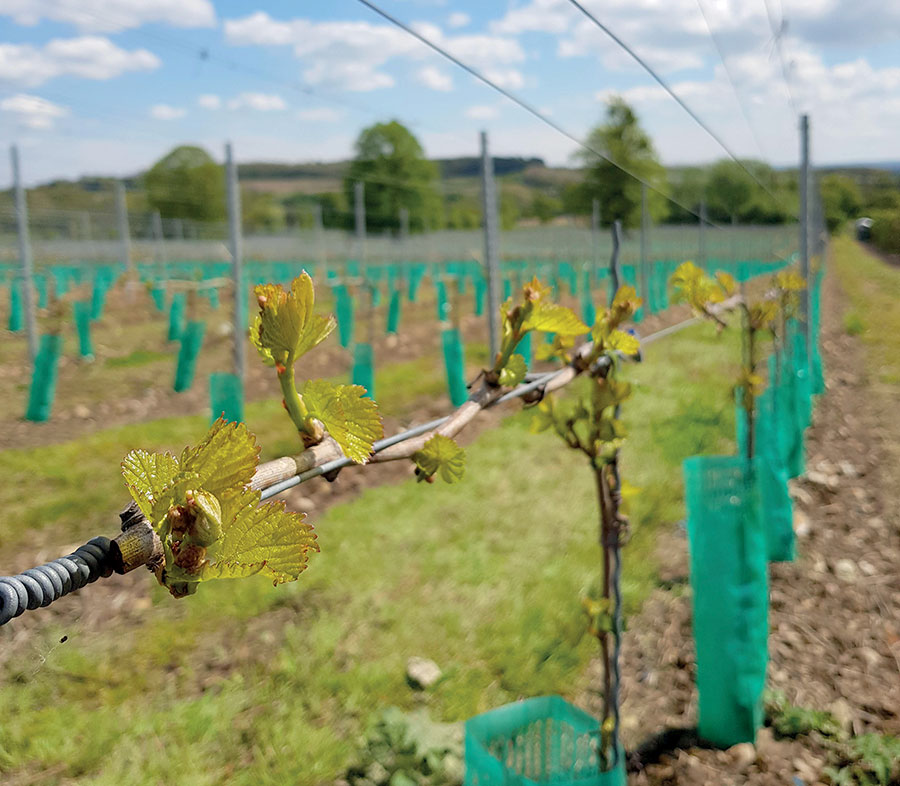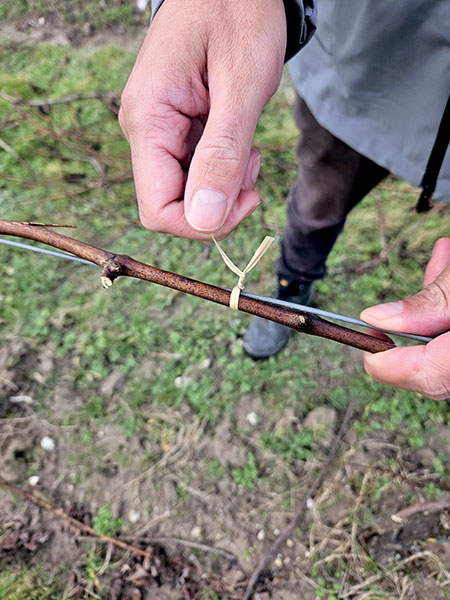Top tips for tying down your vineyard
5th April 2024
VineWorks viticulturalist, Sam Middleton, offers his advice on how and when to tie down canes in order to boost the health and yield of your vines.

Of the more than 4.5 million vines that VineWorks has planted in the UK, the vast majority are likely to be pruned to a Guyot (cane) system – one or two canes, and below them, one or two renewal spurs.
After winter pruning, the canes will usually be slanting upwards. If left like this, the buds at the top of the cane will be prioritised by the vine and grow first due to acrotony – a genetic property of the vine. Their growth will inhibit budburst lower down the cane, risking non-uniform shoot growth and ripening.
Tying canes horizontally to the fruiting wire is a simple but critical viticultural task. The primary objective is to shape vine architecture: encourage even budbreak and balanced shoot growth, maximise sunlight interception and air circulation, reduce shading and humidity, and ultimately, enhance yield and grape quality. Although the task is simple – usually wrapping the cane(s) of each vine once around the fruiting wire before fixing it with one tie – it is time- and labour-intensive. It is also time-sensitive.
When to tie down
Ideally, tying down is performed once the grapevines emerge from winter dormancy and the sap begins to rise. At this point, the canes are less brittle, meaning they can be more easily manipulated – sometimes by gently cracking them – into the optimal position along the fruiting wire. Trying to do this too early can result in snapped canes and a significant loss of yield.
In many vineyards, spring frost poses a significant risk. To mitigate this, the decision may be taken to delay tying down or leave sacrificial canes until the frost risk has hopefully passed. Both tactics seek to exploit two things: Firstly, grapevine acrotony – protecting buds lower down the cane by delaying their development (the further developed they are, the higher the risk); and secondly, the fact that the further they are from the ground, the better protected buds are from the more common radiation frost.
However, delaying tying down can be problematic, because uneven budburst and shoot growth can have far-reaching effects throughout the season. Tying down shoots that are already growing is risky because they are vulnerable to being damaged, reducing yield. Performing this task more carefully (slowly) represents increased time and costs.
A more common approach is to leave a sacrificial cane (standing upright), while the first cane is tied down to the fruiting wire to encourage uniform budburst and growth. After assessing damage following the last expected frost event, the sacrificial cane can be used to replace the original (now damaged) one. If the original cane has escaped damage, the sacrificial one can be removed. These additional steps also require time and labour, with the associated costs. Therefore, speed is another important consideration when tying down.
Equipment and sundries
There are two primary ways to tie down. Simplest is to use paper-coated twist ties by hand. They are effective, affordable, and require very little training. An experienced vineyard worker might tie down over 800 vines per day (whether there are one or two canes will affect timings). Those with less experience will manage significantly fewer. Ties come in 12cm and 15cm lengths to account for different cane thickness, and have the added benefit of being biodegradable, removing the need to collect them, saving time.

The other method is a handheld binder. They are more expensive than hand ties, but considerably faster. An experienced operator can reduce labour time by one third or more. However, the twisting mechanism – which usually applies a tie from a roll connected to the machine – can malfunction. The equipment should be well maintained, and operators trained in its use so problems can be fixed quickly.
In our experience, when it comes to tying machines, the less complicated the better. Electric tying machines come with battery packs to last a full day. There are also less expensive (and less complex) manual ones with similar speeds as their electric counterparts, but at a lower cost, and with less to go wrong. Ligatex is a widely used tying tool applying galvanised wire, while a newer cost-effective option is the semi-automatic tool manufactured by La Cruz which can apply biodegradable ties.
Ultimately the most suitable method of tying down will differ between vineyards and should be selected after consideration of the factors outlined above.
About our expert
VineWorks has been establishing, servicing and supplying UK vineyards since 2006. With over 4.5 million vines planted, 300 vineyards established and thousands of tonnes of grapes hand-harvested, the company’s expertise comes from experience.
Read more vine news
